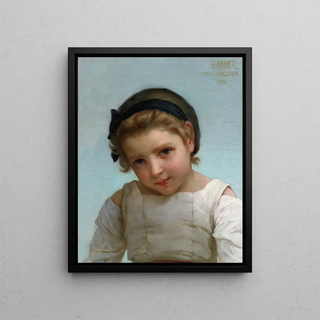Art print | Portrait of a young girl - Émile Munier


View from behind

Frame (optional)
The "Portrait of a Young Girl" by Émile Munier is a piece that leaves no one indifferent. This work, imbued with softness and delicacy, captures the very essence of youth through the gaze of a young girl, both dreamy and full of life. Munier, a master of portraiture, manages to transcend mere pictorial rendering to offer a true window into the soul of his subject. This painting, which evokes timeless beauty and the fragility of childhood, invites the viewer to introspective contemplation, to meet their own memories and emotions.
Style and uniqueness of the work
The uniqueness of this piece lies in Émile Munier's technical mastery, which combines a palette of gentle colors with subtly crafted lighting. The features of the young girl's face are rendered with almost photographic precision, while the texture of the clothing and hair is delicately suggested by skillful brushstrokes. Munier uses light to highlight the model's eyes, which seem to sparkle in an almost magical way. This play of shadows and light gives the work an almost lifelike dimension, as if the young girl could come to life at any moment. The composition, centered on the face, immediately draws the eye and creates a strong emotional connection between the artwork and the viewer.
The artist and his influence
Émile Munier, born in 1840, was a French artist whose talent manifested from a young age. Trained at the École des Beaux-Arts in Paris, he established himself in the art world through his realistic approach and his ability to capture human essence. Influenced by masters of the past, notably the great portraitists of the 17th and 18th centuries, Munier reinterpreted these techniques with a sensitivity unique to his era. His works, often populated with young girls and women, testify to a fascination with feminine beauty and the purity of childhood. Through his portraits, he also contributed to the evolution of the genre by incorporating elements of daily life and focusing on the inner emotions of his models. His influence endures,

Matte finish

View from behind

Frame (optional)
The "Portrait of a Young Girl" by Émile Munier is a piece that leaves no one indifferent. This work, imbued with softness and delicacy, captures the very essence of youth through the gaze of a young girl, both dreamy and full of life. Munier, a master of portraiture, manages to transcend mere pictorial rendering to offer a true window into the soul of his subject. This painting, which evokes timeless beauty and the fragility of childhood, invites the viewer to introspective contemplation, to meet their own memories and emotions.
Style and uniqueness of the work
The uniqueness of this piece lies in Émile Munier's technical mastery, which combines a palette of gentle colors with subtly crafted lighting. The features of the young girl's face are rendered with almost photographic precision, while the texture of the clothing and hair is delicately suggested by skillful brushstrokes. Munier uses light to highlight the model's eyes, which seem to sparkle in an almost magical way. This play of shadows and light gives the work an almost lifelike dimension, as if the young girl could come to life at any moment. The composition, centered on the face, immediately draws the eye and creates a strong emotional connection between the artwork and the viewer.
The artist and his influence
Émile Munier, born in 1840, was a French artist whose talent manifested from a young age. Trained at the École des Beaux-Arts in Paris, he established himself in the art world through his realistic approach and his ability to capture human essence. Influenced by masters of the past, notably the great portraitists of the 17th and 18th centuries, Munier reinterpreted these techniques with a sensitivity unique to his era. His works, often populated with young girls and women, testify to a fascination with feminine beauty and the purity of childhood. Through his portraits, he also contributed to the evolution of the genre by incorporating elements of daily life and focusing on the inner emotions of his models. His influence endures,






